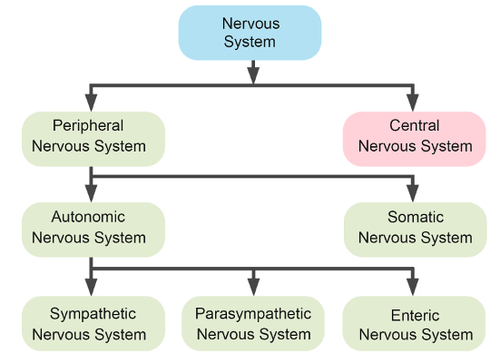
Nervous System
PANCHKOSH SADHNA – Online Global Class – 13 Aug 2022 (5:00 am to 06:30 am) – Pragyakunj Sasaram _ प्रशिक्षक श्री लाल बिहारी सिंह
ॐ भूर्भुवः स्वः तत्सवितुर्वरेण्यं भर्गो देवस्य धीमहि धियो यो नः प्रचोदयात् ।
SUBJECT: Introduction to the Nervous System
Broadcasting: आ॰ अमन जी/ आ॰ अंकुर जी/ आ॰ नितिन जी
शिक्षक बैंच: आ॰ डॉ॰ शिवांगी सिंह जी (कर्नाटक, बैंगलोर)
Neurons are the fundamental units of the brain and nervous system, the cells responsible for receiving sensory input from the external world, for sending motor commands to our muscles, and for transforming and relaying the electrical signals at every step in between.
The Nervous System is the human organ system that coordinates all of the body’s voluntary and involuntary actions, by transmitting signals to and from different parts of the body.
The two main divisions of the nervous system:-
1. The Central Nervous System (CNS) — includes the brain and spinal cord
2. The Peripheral Nervous System (PNS) – includes nerves and ganglia (singular, ganglion), which transmit information between the CNS to the rest of the body. It is further divided into two divisions:-
(a) Autonomic Nervous System
(b) Somatic Nervous Systems
The autonomic nervous system controls activities that are not under voluntary control, such as digesting a meal. It has three main divisions:-
1. The sympathetic division controls the fight-or-flight response during emergencies.
2. The parasympathetic division controls the routine “housekeeping” functions of the body at other times.
3. The enteric division provides local control of the digestive system.
The somatic system controls activities that are under voluntary control.
Electrical signals sent by the nervous system are called nerve impulses. They are transmitted by special cells called neurons.
The brain can be divided into three basic units:-
1. The forebrain,
2. The midbrain and
3. The hindbrain.
The brain has three main parts:-
1. The cerebrum – the largest part of the brain, composed of right and left hemispheres, performs higher functions – like interpreting touch, vision and hearing, as well as speech, reasoning, emotions, learning, and fine control of movement.
2. The cerebellum – located under the cerebrum. Functions – to coordinate muscle movements, maintain posture, and balance.
3. The brainstem – relay center connecting the cerebrum and cerebellum to the spinal cord. Functions – breathing, heart rate, body temperature, wake and sleep cycles, digestion, sneezing, coughing, vomiting, and swallowing.
The four lobes of the brain:-
1. The frontal lobe,
2. The parietal lobe,
3. The temporal lobe, and
4. The occipital lobe
The limbic system – involved in our behavioural and emotional responses. 4 Parts of the limbic system:-
1. The thalamus,
2. The amygdala,
3. The hippocampus and
4. The hypothalamus.
(प्राणाकर्षण) प्राणायाम का Nervous System पर प्रभाव :-
1. Olfactory bulb – directly limbic system से connected है और जो प्राणायाम के rhythmic vibrations हैं, वहां पहूंचते हैं ।
2. Pre Botzinger area (जो medulla oblongata में स्थित है) sets neural rhythm.
3. Pre motor and motor cortex – part of parietal lobe – stimulated during प्राणायाम ।
The pineal gland (third eye) is a small gland located deep in the center of the brain. यह दो हार्मोन स्रावित करती हैं मिलेटोनिन (90-95%) व सिरोटोनिन (5-10%) । इसके जागरण हेतु – ‘ध्यान, धारणा, समाधि’ अर्थात् हमें meditation की गहराई में प्रवेश करना होता है ।
Brain Waves Frequencies:-
1. Gamma (greater than 30 Hz),
2. Beta (13 – 30 Hz),
3. Alpha (8 – 12 Hz),
4. Theta (4 – 8 Hz),
5. Delta (less than 4 Hz)
Meditation (ध्यान – धारणा – समाधि) से हम needed brain frequency पर जाकर कार्य कर सकते हैं । @ मनोबुद्धयहंकारचित्तानि नाहम् …. चिदानन्द रूप: शिवोऽहम् शिवोऽहम् ॥
Query Session
Brainwaves (Neural oscillations) are rhythmic or repetitive patterns of neural activity in the CNS. EEG machine can read brain wave frequencies.
The enteric division provides local control of the digestive system.
ध्यानात्मक गहराइयों में जाकर स्वयं को शांत, संयमित संतुलित, स्थितप्रज्ञ, जीवनमुक्त अच्युत अवस्था की स्थिति प्राप्त करते हैं तब वो स्थिति आती है कि – हे अर्जुन! तु युद्ध भी कर और मेरा स्मरण भी (गामा स्टेट) ।
शब्द, रूप, रस, गंध व स्पर्श जब सुकून देती हैं तो हमें अच्छा लगता है । प्रारंभ में हम पूजा उपासना पद्धति में सात्विक रूपेण इनका आश्रय भी लेते हैं । धीरे धीरे इनसे परे निरालंब की भी स्थिति आती है ।
जिज्ञासा समाधान (श्री लाल बिहारी सिंह ‘बाबूजी’)
अध्यात्मिक तथ्यों का वर्तमान scientific interpretation आवश्यक है । शिवांगी जी को स्नेहाशीष साभार ।
Meditation से त्रिगुणातीत (तीन गुण – सत्व, रज व तम की साम्यावस्था) हुआ जा सकता है ।
Pineal Gland (third eye – ज्ञानेन मुक्ति @ प्रज्ञानं ब्रह्म) जागरण से हम स्वयं का और संसार का ठीक ठीक पूर्ण ज्ञान प्राप्त कर सकते हैं @ अद्वैत । विज्ञानमयकोश सिद्धि में अतीन्द्रिय क्षमताओं का जागरण हो जाता है ।
ॐ शांतिः शांतिः शांतिः ।।
Writer: Vishnu Anand

No Comments